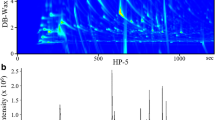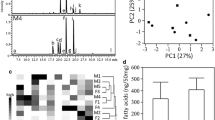Abstract
We report the volatile composition of the body scent of male C57BL/6J mice in comparison to the volatile composition of their urine. From a total of 67 components, nitromethane, propanoic acid, dimethyldisulfide, 1-octene, 1-hexanol, hexanoic acid, indole, α- and β-farnesene, and one unidentified component were observed only in the volatiles from the body of mice. On the other hand, 3-penten-2-one, 3-methyl-2-buten-1-ol, 3-methyl-cyclopentanone, p-xylene, 3-hepten-2-one, 2,3-dehydro-exo-brevicomin, benzylmethylketone, and 13 unidentified components were only found in urine volatiles. All other substances were present in the volatiles of both mice and their urine. Aliphatic aldehydes from pentanal to decanal were prominent mouse odor components. Because receptors for these aldehydes have been extensively characterized in the main olfactory organ, these components may be important for mice in recognizing their conspecifics.




Similar content being viewed by others
References
Araneda, R. C., Kini, A. D., and Firestein, S. 2000. The molecular receptive range of an odorant receptor. Nat. Neurosci. 3:1248–1255.
Araneda, R. C., Peterlin, Z., Zhang, X., Chesler, A., and Firestein, S. 2004. A pharmacological profile of the aldehyde receptor repertoire in rat olfactory epithelium. J. Physiol. 555.3:743–756.
Bacchini, A., Gaetani, E., and Cavaggioni, A. 1992. Pheromone binding proteins of the mouse, Mus musculus. Experientia 48:419–421.
Bernier, U. R., Kline, D. L., Barnard, D. R., Schreck, C. E., and Yost, R. A. 2000. Analysis of human skin emanations by gas chromatography/mass spectrometry. 2. Identification of volatile compounds that are candidate attractants for the yellow fever mosquito (Aedes aegypti). Anal. Chem. 72:747–756.
Brennan, P. A. and Keverne, E. B. 2004. Something in the air? New insights into mammalian pheromones. Curr. Biol. 14:R81–R89.
Brown, R. E., Schellinck, H. M., and West, A. M. 1996. The influence of dietary and genetic cues on the ability of rats to discriminate between the urinary odors of MHC-congenic mice. Physiol. Behav. 60:365–372.
Curran, A. M., Rabin, S. I., Prada, P. A., and Furton, K. G. 2005. Comparison of the volatile organic compounds present in human odor using SPME-GC/MS. J. Chem. Ecol. 31:1607–1619.
Haze, S., Gozu, Y., Nakamura, S., Kohno, Y., Sawano, K., Ohta, H., and Yamazaki, K. 2001. 2-Nonenal newly found in human body odor tends to increase with aging. J. Invest. Dermatol. 116:520–524.
Julius, D. and Katz, L. C. 2004. A Nobel for smell. Cell 119:747–752.
Kaluza, J. F. and Breer, H. 2000. Responsiveness of olfactory neurons to distinct aliphatic aldehydes. J. Exp. Biol. 203:927–933.
Krautwurst, D., Yau, K. W., and Reed, R. R. 1998. Identification of ligands for olfactory receptors by functional expression of a receptor library. Cell 95:917–926.
Lin, D. Y., Zhang, S.-Z., Block, E., and Katz, L. C. 2005. Encoding social signals in the mouse main olfactory bulb. Nature 434:470–477.
Luo, M., Fee, M. S., and Katz, L. C. 2003. Encoding pheromonal signals in the accessory olfactory bulb of behaving mice. Science 299:1196–1201.
Miyashita, K. and Robinson, A. B. 1980. Identification of compounds in mouse urine vapor by gas chromatography and mass spectrometry. Mech. Ageing Dev. 13:177–184.
Montag, S., Frank, M., Ulmer, H., Wernet, D., GÖpel, W., and Rammensee, H.-G. 2001. “Electronic nose” detects major histocompatibility complex-dependent prerenal and postrenal odor components. Proc. Natl. Acad. Sci. USA 98:9245–9254.
Novotny, M. V. 2003. Pheromones, binding proteins and receptor responses in rodents. Biochem. Soc. Transact. 31:117–122.
Novotny, M., Harvey, S., and Jemiolo, B. 1990. Chemistry of male dominance in the house mouse, Mus domesticus. Experientia 46:109–113.
Novotny, M. V., Jemiolo, B., Wiesler, D., Ma, W., Harvey, S., Xu, F., Xie, T.-M., and Carmack, M. 1999a. A unique urinary constituent, 6-hydroxy-6-methyl-3-heptanone, is a pheromone that accelerates puberty in female mice. Chem. Biol. 6:377–383.
Novotny, M. V., Ma, W., Wiesler, D., and Zidek, L. 1999b. Positive identification of the puberty-accelerating pheromone of the house mouse: The volatile ligands associating with the major urinary protein. Proc. R. Soc. Lond. B 266:2017–2022.
Schwende, F. J., Wiesler, D., Jorgenson, J. W., Carmack, M., and Novotny, M. 1986. Urinary volatile constituents of the house mouse, Mus musculus, and their endocrine dependency. J. Chem. Ecol. 12:277–296.
Singer, A. G., Beauchamp, G. K., and Yamazaki, K. 1997. Volatile signals of the major histocompatibility complex in male mouse urine. Proc. Natl. Acad. Sci. USA 94:2210–2214.
Sioni, H. A., Bruce, K. E., Wiesler, D., David, F., Sandra, P., and Novotny, M. V. 2005. Stirr bar sorptive extraction: A new quantitative and comprehensive sampling technique for determination of chemical signal profiles from biological media. J. Chem. Ecol. 31:377–392.
Stowers, L. and Marton, T. F. 2005. What is a pheromone? Mammalian pheromones reconsidered. Neuron 46:699–702.
Willse, A., Belcher, A. M., Preti, G., Wahl, J. H., Thresher, M., Yang, P., Yamazaki, K., and Beauchamp, G. K. 2005. Identification of major histocompatibility complex-regulated body odorants by statistical analysis of a comparative gas chromatography/mass spectrometry experiment. Anal. Chem. 77:2348-2361.
Zhao, H., Ivic, L., Otaki, J. M., Hashimoto, M., Mikoshiba, K., and Firestein, S. 1998. Functional expression of a mammalian odorant receptor. Science 179:237–242.
Acknowledgments
We thank Dr. H. Mossman (Freiburg) for providing mice, K.Mori (Tokyo), C. Mucignat (Padova), and P. Landolt (Wapato, Wa) for donating standards, and Dr. J. Kopka (Berlin) for help in the interpretation of mass spectra. Helpful suggestions by Dr. M. Wandel and Prof. K.P. Hadeler and technical help by A. Hohneder and B. Pömmerl are gratefully acknowledged. P.O. thanks the Max-Planck-Gesellschaft for generous support.
Author information
Authors and Affiliations
Corresponding author
Electronic Supplementary Material
The measurements refer to the analysis of mouse body odor or urine volatiles, respectively, for C57BL/6J mice (wild type), germ-free or matching C57BL/6 mice raised under specific-pathogen-free (SPF) conditions. Mice used for the experiments have been serially numbered (mouse #). The spectra have been designated as indicated (spectrum #).
The table shows the relative total ion current for all components defined by their substance number and retention time (see Table 1). The plus (+) refers to the detection of characteristic fragments for the respective component.
Table 1
(PDF 46 kb)
Rights and permissions
About this article
Cite this article
Röck, F., Mueller, S., Weimar, U. et al. Comparative Analysis of Volatile Constituents from Mice and their Urine. J Chem Ecol 32, 1333–1346 (2006). https://doi.org/10.1007/s10886-006-9091-2
Received:
Revised:
Accepted:
Published:
Issue Date:
DOI: https://doi.org/10.1007/s10886-006-9091-2




